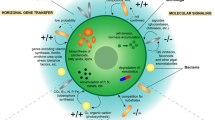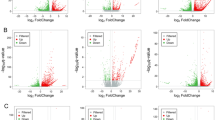Abstract
Rising seawater temperatures cause coral bleaching. The molecular responses of the coral holobiont under stress conditions, determine the success of the symbiosis. Anomastraea irregularis is a hard coral commonly found in the harsh intertidal zones of the south coast of KwaZulu-Natal (KZN), South Africa, where it thrives at the very margins of hard coral distribution in the Western Indian Ocean. To identify the possible molecular and cellular mechanisms underlying its resilience to heat stress, experimental and control nubbins were exposed to temperatures of 29 and 19 °C respectively for 24 h. The transcriptome was assembled de novo from 42.8 million quality controlled 63 bp paired-end short sequence reads obtained via RNA sequencing (RNA-seq). The assembly yielded 333,057 contigs (> 500 bp = 55,626, Largest = 6341 bp N50 = 747 bp). 1362 (1.23%) of the transcripts were significantly differentially expressed between heat stressed and control samples. Log fold change magnitudes among individual genes ranged from − 4.6 to 7.2. Overall, the heat stress response in the A. irregularis constituted a protective response involving up regulation of apoptosis and SUMOylation. Gene ontology (GO) analyses revealed that heat stress in the coral affected the metabolism, protein synthesis, photosynthesis, transport and cytoskeleton. This is the first study to produce a reference transcriptome of this coral species and analyze its response to heat stress. The assembled transcriptome also presents a valuable resource for further transcriptomic and genomic studies.




Similar content being viewed by others
Data availability
The transcriptome data will be uploaded to Springer Nature Research Data Support.
References
Berkelmans R, Van Oppen M (2006) The role of zooxanthellae in the thermal tolerance of corals: a ‘nugget of hope’ for coral reefs in an era of climate change. Proc R Soc Lond 273:2305–2312
Fransolet D, Roberty S, Plumier J (2012) Establishment of endosymbiosis: the case of cnidarians and Symbiodinium. J Exp Mar Biol Ecol 420–421:1–7
Hoegh-Guldberg O (1999) Climate change, coral bleaching and the future of the worldís coral reefs. Mar Freshwater Res 50:839–866
Hughes T, Baird A, Bellwood D, Card M, Connolly S, Folke C et al (2003) Climate change, human impacts, and the resilience of coral reefs. Science 301:929–933
Baker C, Glynn W, Riegl B (2008) Climate change and coral reef bleaching: an ecological assessment of long-term impacts, recovery trends and future outlook. Estuar Coast Shelf Sci 80:435–471
Barshis D, Ladner J, Oliver T, Seneca F, Traylor-Knowles N, Palumbi S (2013) Genomic basis for coral resilience to climate change. Proc Natl Acad Scie USA 110:1387–1392
Kaniewska P, Chan C, Kline D, Ling E, Rosic N, Edwards D et al (2015) Transcriptomic changes in coral holobionts provide insights into physiological challenges of future climate and ocean change. PLoS ONE. https://doi.org/10.1371/journal.pone.0139223
Hughes TP, Kerry JT, Simpson T (2018) Large-scale bleaching of corals on the great barrier reef. Ecology 99:501
Van Oppen J, Gates R (2006) Conservation genetics and the resilience of reef-building corals. Mol Ecol 15:3863–3883
Edge S, Morgan M, Gleason D, Snell T (2005) Development of a coral cDNA array to examine gene expression profiles in Montastraea faveolata exposed to environmental stress. Mar Pollut Bull 51:507–523
Traylor-Knowles N, Rose NH, Sheets EA, Palumbi SR (2017) Early transcriptional responses during heat stress in the coral Acropora hyacinthus. Biol Bull 232:91–100
Meron D, Maor-Landaw K, Weizman E, Ben-Asher HW, Eyal G, Banin E et al (2019) The algal symbiont modifies the transcriptome of the scleractinian coral Euphyllia paradivisa during heat stress. Microorganisms 7:256. https://doi.org/10.3390/microorganisms7080256
DeSalvo M, Sunagawa S, Fisher P, Voolstra C, Iglesias-Prieto R, Medina M (2010) Coral host transcriptomic states are correlated with Symbiodinium genotypes. Mol Ecol 19:1174–1186
Seneca F, Palumbi S (2015) The role of transcriptome resilience in resistance of corals to bleaching. Mol Ecol 24:1467–1484
Edge S, Shearer T, Morgan M, Snell T (2013) Sub-lethal coral stress: detecting molecular responses of coral populations to environmental conditions over space and time. Aquat Toxicol 128–129:135–146
DeSalvo M, Sunagawa S, Voolstra C, Medina M (2010) Transcriptomic responses to heat stress and bleaching in the elkhorn coral Acropora palmata. Mar Ecol Prog Ser 402:97–113
Meyer E, Aglyamova G, Matz M (2011) Profiling gene expression responses of coral larvae (Acropora millepora) to elevated temperature and settlement inducers using a novel RNA-Seq procedure. Mol Ecol 20:3599–3616
Jiang H, Wong WH (2009) Statistical inferences for isoform expression in RNA-Seq. Bioinformatics 25:1026–1032
Meyer E, Aglyamova GV, Wang S, Buchanan-Carter J, Abrego D, Colbourne JK et al (2009) Sequencing and de novo analysis of a coral larval transcriptome using 454 GSFlx. BMC Genomics. https://doi.org/10.1186/1471-2164-10-219
Kenkel C, Meyer E, Matz M (2013) Gene expression under chronic heat stress in populations of the mustard hill coral (Porites astreoides) from different thermal environments. Mol Ecol 22:4322–4334
Shinzato C, Inoue M, Kusakabe M (2014) A snapshot of a coral “Holobiont”: a transcriptome assembly of the scleractinian coral, Porites, captures a wide variety of genes from both the host and symbiotic zooxanthellae. PLoS ONE. https://doi.org/10.1371/journal.pone.0085182
Ryu T, Cho W, Yum S, Woo S (2019) Holobiont transcriptome of colonial scleractinian coral Alveopora japonica. Mar Genomics 43:68–71
Traylor-Knowles N, Granger B, Lubinski T, Parikh J, Garamszegi S, Xia Y et al (2011) Production of a reference transcriptome and transcriptomic database (PocilloporaBase) for the cauliflower coral, Pocillopora damicornis. BMC Genomics 12:1471–2164
Smit PK, Glassom D (2017) Large fluctuations but constant mean temperatures allow corals to persist in intertidal rock pools on the east Coast of South Africa. Helgoland Mar Res. https://doi.org/10.1186/s10152-017-0482-2
Obura D, Di Carlo D, Rabearisoa A, Oliver T (2011) A rapid marine biodiversity assessment of the coral reefs of northeast Madagascar. Conservation International, Arlington
Bolger AM, Lohse M, Usadel B (2014) Trimmomatic: a flexible trimmer for Illumina sequence data. Bioinformatics 30:2114–2120
Grabherr MG, Haas BJ, Yassour M, Levin JZ, Thompson AD, Amit I et al (2011) Full-length transcriptome assembly from RNA-Seq data without a reference genome. Nat Biotechnol 29:644–652
Kim D, Langmead B, Salzberg SL (2015) HISAT: a fast spliced aligner with low memory requirements. Nat Methods 12:357–362
Pertea M, Pertea GM, Antonescu CM, Chang TC, Mendell JT, Salzberg SL (2015) StringTie enables improved reconstruction of a transcriptome from RNA-seq reads. Nat Biotechnol 33:290–295
Love MI, Huber W, Anders S (2014) Moderated estimation of fold change and dispersion for RNA-seq data with DESeq2. Genome Biol 15:1–21
Haas BJ, Papanicolaou A, Yassour M, Grabherr M, Blood PD, Bowden J et al (2013) De novo transcript sequence reconstruction from RNA-seq using the Trinity platform for reference generation and analysis. Nat Protoc 8:1494–1512
Gurevich A, Saveliev V, Vyahhi N, Tesler G (2013) QUAST: quality assessment tool for genome assemblies. Bioinformatics 29:1072–1075
Gotz S, Garcia-Gomez JM, Terol J, Williams TD, Nagaraj SH, Nueda MJ et al (2008) High-throughput functional annotation and data mining with the Blast2GO suite. Nucleic Acids Res 36:3420–3435
Huerta-Cepas J, Forslund K, Coelho LP, Szklarczyk D, Jensen LJ, von Mering C, Bork P (2017) Fast genome-wide functional annotation through orthology assignment by eggNOG-mapper. Mol Biol Evol. https://doi.org/10.1093/molbev/msx148
Bay R, Palumbi S (2015) Rapid acclimation ability mediated by transcriptome changes in reef-building corals. Genome Biol Evol 7:1602–1612. https://doi.org/10.1093/gbe/evv085
Vidal-Dupiol J, Zoccola D, Tambutte E, Grunau C, Cosseau C, Smith K et al (2013) Genes related to ion-transport and energy production are upregulated in response to CO2-driven pH decrease in corals: new insights from transcriptome analysis. PLoS ONE. https://doi.org/10.1371/journal.pone.0058652
Conesa A, Madrigal P, Sonia TS, Gomez-Cabrero D, Cervera A, McPherson A et al (2016) A survey of best practices for RNA-seq data analysis. Genome Biol. https://doi.org/10.1186/s13059-016-0881-8
Desalvo M, Voolstra C, Sunagawa S, Schwarz J, Stillman J (2008) Differential gene expression during thermal stress and bleaching in the Caribbean coral Montastraea faveolata. Mol Ecol 17:3952–3971
Coppé J, Desprez P, Krtolica A, Campisi J (2010) The Senescence-associated secretory phenotype: the dark side of tumor suppression. Annu Rev Pathol 5:99–118
Voolstra CR, Schnetzer J, Peshkin L, Randall CJ, Szmant AM, Medina M (2009) Effects of temperature on gene expression in embryos of the coral Montastraea faveolata. BMC Genomics. https://doi.org/10.1186/1471-2164-10-627
Cao F, Miao Y, Xu K, Liu P (2015) Lethal (2) giant larvae: an indispensable regulator of cell polarity and cancer development. Int J Biol Sci 11:380–389
Wodarz A, Gonzalez C (2006) Connecting cancer to the asymmetric division of stem cells. Cell 124:1121–1123
Parker A, Kavallaris M, McCarroll JA (2014) Microtubules and their role in cellular stress in cancer. Front Oncol. https://doi.org/10.3389/fonc.2014.00153
Smertenko A, Draber P, Viklicky V, Opatrny Z (1997) Heat stress affects the organization of microtubules and cell division in Nicotiana tabacum cells. Plant Cell Environ 20:1534–1542
Guo C, Henley GM (2014) Wrestling with stress: roles of protein SUMOylation and deSUMOylation in cell stress response. Int Union Biochem Mol Biol 66:71–77
Takahashi S, Nakamura T, Sakamizu M, Woesik R, Yamasaki H (2004) Repair machinery of symbiotic photosynthesis as the primary target of heat stress for reef-building corals. Plant Cell Physiol 45:251–255
Downs CA, Mueller E, Phillips S, Fauth JE, Woodley CM (2000) A molecular biomarker system for assessing the health of coral (Montastraea faveolata) during heat stress. Mar Biotechnol 2:533–544
Spiering D, Hodgson L (2011) Dynamics of the Rho-family small GTPases in actin regulation and motility. Cell Adh Migr 5:170–180
Acknowledgements
We thank postgraduate students in the Marine Biology and Marine Evolution Laboratories for their invaluable support during sampling and nucleic acid extractions. Special thanks go to Centre for Proteomic and Genomic Research (CPGR) South Africa for sequencing services. We appreciate the assistance from the technical and administrative staff in the school of Life sciences, University of KwaZulu-Natal, Westville Campus.
Funding
This research was supported by the National Research Fund (NRF) South Africa, and Gay Langmuir Bursary.
Author information
Authors and Affiliations
Contributions
All authors contributed to the study conception and design. Material preparation, data collection and analysis were performed by CAO. The first draft of the manuscript was written by CAO, and all authors commented on previous versions of the paper. All authors read and approved the final manuscript.
Corresponding author
Ethics declarations
Conflict of interest
On behalf of the authors, the corresponding author states that there is no conflict of interest.
Ethical approval
No ethics approval was required as the coral is not considered endangered. Sampling permit number RES 2019/93 was used.
Additional information
Publisher's Note
Springer Nature remains neutral with regard to jurisdictional claims in published maps and institutional affiliations.
Supplementary Information
Below is the link to the electronic supplementary material.
11033_2021_6184_MOESM2_ESM.docx
Supplementary file 2 (DOCX 14 KB) Online Resource 2 Quast generated statistics of the assembled A. irregularis transcriptome
11033_2021_6184_MOESM5_ESM.jpg
Supplementary file 5 (JPG 195 KB) Online Resource 5 MA plot showing log fold changes of differentially expressed genes between A. irregularis heat stressed and control samples. Each of the dots represent transcripts. Significantly differentially expressed transcripts are coloured in red
11033_2021_6184_MOESM8_ESM.docx
Supplementary file 8 (DOCX 14 KB) Online Resource 8 Quast generated de novo transcriptome post-processing metrics (processing of de novo assembled transcripts into putative coding sequences)
11033_2021_6184_MOESM9_ESM.png
Supplementary file 9 (PNG 291 KB) Online Resource 9 Annotation distribution among (A) A. irregularis heat stressed (B) A. irregularis control contigs
Rights and permissions
About this article
Cite this article
Onyango, C.A., Glassom, D. & MacDonald, A. De novo assembly of the transcriptome of scleractinian coral, Anomastraea irregularis and analyses of its response to thermal stress. Mol Biol Rep 48, 2083–2092 (2021). https://doi.org/10.1007/s11033-021-06184-5
Received:
Accepted:
Published:
Issue Date:
DOI: https://doi.org/10.1007/s11033-021-06184-5




